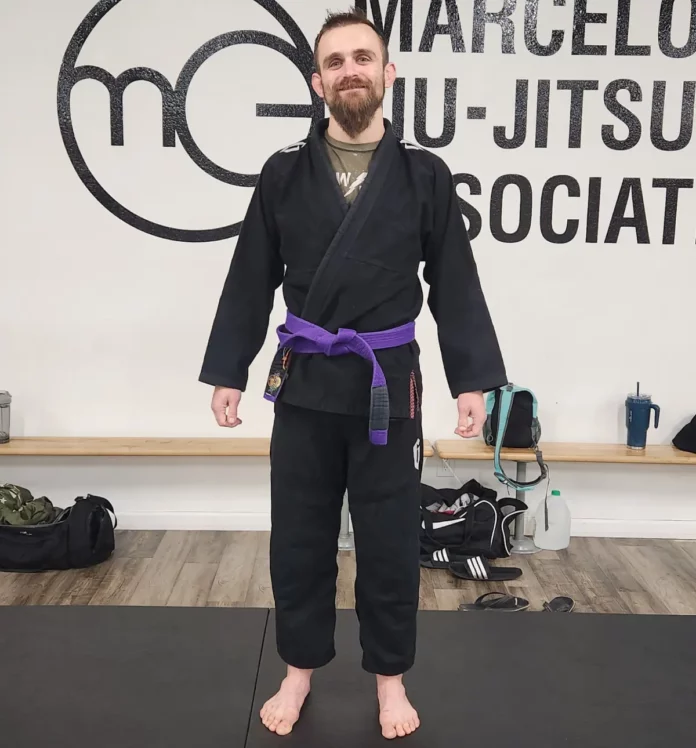It generally takes between 3 and 6 years to earn a purple belt in BJJ.
The specifics of how long it will take you to get BJJ purple belt depend on the frequency, focus, and consistency of your training.
It personally took me 4.5 years to get my Jiu Jitsu purple belt, with 1 year spent as a white belt and then 3.5 years at BJJ blue belt before finally earning the rank of purple belt.
I have seen BJJ practitioners get promoted to purple belt in Jiu Jitsu much faster, in some cases around 3 years, although these were all exceptions to the general rule.
In this article, I break down everything you need to know about the length of time it can take to get a Brazilian Jiu Jitsu purple belt based on my experience getting to BJJ purple.
I’ll look at the following areas of this topic:
- Average time to BJJ purple
- Calculator for estimating time to purple belt
- Factors affecting how long it takes for purple belt
- Purple belt technique & other requirements
- FAQs about BJJ purple belt
Let’s get to it!
Table of Contents
How Long to Get a Purple Belt in BJJ?
Typically, after starting BJJ, it might take anywhere from 3-8 years to achieve a purple belt.
An average time with consistent training and minimal injuries can take a person probably about 5 years, including the time it takes to go from white to blue belt, and then blue to purple belt.
The time is take will vary based on your training schedule, Jiu Jitsu class attendance consistency, and how much focus you put into BJJ overall.
The reason their is such a wide range in time to get purple belt is because a lot can happen in the timespan it takes to get your purple belt promotion.
Injuries, life events like work career transitions or starting a family and having kids, and all manner of other considerations can affect your ability to train BJJ, and thus, the time it will take you to reach any given belt level.
Time to BJJ Purple Belt Calculator
Use the calculator below to get an estimate for how long it will take to get your purple belt based on your training.
BJJ Purple Belt Calculator
| Classes Per Week: | |
| Average Class Duration (minutes): | |
| Do You Compete? | |
| Prior Experience in Other Grappling? | |
| Supplemental Coursework? | |
General Factors Affecting How Long to BJJ Purple Belt
The following factors will influence how long it takes to you your Brazilian Jiu Jitsu purple belt:
- Training Frequency: Someone training four times a week will likely progress faster than someone training once a week.
- Competition Participation: Engaging in competitions can fast-track learning and improvement.
- Quality of Instruction: Having a skilled professor in both coaching and competing can make all the difference.
- Injuries: a bad injury can cost weeks to months of training time, setting your timeline for BJJ purple back.
- Using External Resources: studying with BJJ courses
However, the BJJ purple belt requirements are not solely about time.
It’s about skill acquisition, understanding, and embodiment of the sport. It's about moving from the stage of copying techniques to truly understanding them.
Requirements for Earning a Purple Belt
The International Brazilian Jiu Jitsu Federation has specific IBJJF time-in-grade requirements for any BJJ practitioner to be considered for promotion within the IBJJF system. You are technically required to be a blue belt for a minimum of two years.
This has implications for competing in Jiu-Jitsu based on belt level, as IBJJF only permits you to compete in their events at your belt level based on their standards.
Even if your black belt level instructor promotes you to purple belt, if you do not have the required time at blue belt and didn’t win the blue belt IBJJF world championship, you aren’t eligible to compete at purple in IBJJF.
With all of that said, it takes a high level of dedication to meet or beat the IBJJF belt rank requirements.
For most Jiu Jitsu practitioners, this is never an issue.
If you win the blue belt IBJJF world championship, you are not required to complete the full time in grade.
If you trained as a youth an orange, green or blue belt then this minimum period is waived as well.
While every instructor will have their own curriculum requirements to progress from white and blue belt to purple belt, most people who get promoted to purple belt are competitive with one another within the same age and weight divisions.
Purple belt requires not just a basic knowledge of position and submission fundamentals, but requires you develop your abilities to apply these situations against a variety of opponents.
Some professors may also expect to see self-defense abilities and other basic wrestling movements in their purple belts, depending on the program.
My Experience Getting BJJ Purple Belt
It took me about 4.5 years of dedicated training before I earned my purple belt in Brazilian Jiu-Jitsu.

At the time, I was training at a 10th Planet School in Tucson, Arizona, and as such, earned my purple belt within that no-gi BJJ focused system (note the injury to my anke when I got promoted).
I’ve since moved to another school that does Gi and No Gi Jiu Jitsu to ensure I stay up-to-date on the grips, body awareness, and hand fight skills needed to be successful in both forms of Jiu Jitsu.
Personally, the grind from blue belt to purple belt was a long one for me despite consistent training.
This was in part due to switching BJJ schools and training other martial arts forms including boxing for punches, Muay Thai for comprehensive strikes, and wrestling to be proficient in Mixed Martial Arts skills.
Since then, I’ve switched back to pure BJJ grappling and wrestling and no longer train striking attack martial arts.
Why is the Purple Belt Important in BJJ?
The purple belt in Brazilian Jiu Jitsu is not just another rank. It’s an affirmation of your dedication, skills, and growth as a martial artist.
For many instructors, purple belt is roughly halfway in the overall development towards BJJ black belt.
As such, purple belt is a big achievement, yet it’s still just a small step in the neverendin g journey towards BJJ mastery.
As you’re probably familiar, the BJJ belt order is as follows:
- White Belt: The beginning. Where everyone starts.
- Blue Belt: The next level, showcasing fundamental proficiency.
- Purple Belt: Here, a practitioner demonstrates advanced techniques and begins to develop their own style.
- Brown Belt: Mastery of advanced techniques.
- Black Belt: Deep knowledge of BJJ, considered an overall master
- Red/Coral Belt: Grandmaster - few will ever achieve this rank.
These are the core belt colors in Jiu-Jitsu, although there are other belts and stripes in between, especially for young practitioners.
The Jiu Jitsu purple belt skillset is multifaceted.
As a purple belt in BJJ, you’re expected to have a wide range of techniques at your disposal, but more than that, they've also started to understand the deeper aspects of the game.
They can counter, re-counter, and often predict an opponent's next move.
How many BJJ purple belts in the world?
There are no hard figures as to the total number of BJJ purple belts in the world, since IBJJF does not publish this data nor is every BJJ purple belt registered with the IBJJF. However, the number of purple belts is likely well over 10,000 in the U.S. and much greater globally, but these figures will never be exact.
What Does it Take to Move from Blue to Purple Belt BJJ?
Blue and purple belt are both a single rank away from one another, however that does not mean the skill level is close.
The gap in skill develop from a blue belt to purple belt is far larger than the gap between white and blues.
By the time you are promoted to purple belt, you should be able to threaten brown and black belts in live sparring, even if you are still getting dominated.
To get to this level takes discipline on the mats and in life to accrue the amount of practice and mat time to reach the skill it takes to be a BJJ purple belt. Of course, it is just one small step towards achieving the black belt rank in BJJ.
Consider the following key points in blue belt vs purple belt BJJ skills.
1. Deepened Technical Knowledge
The difference between a blue belt and a purple belt in BJJ is often the depth of technical knowledge.
At the blue belt level, a practitioner learns a vast array of techniques and starts to understand the foundational principles of the art.
However, as they transition towards the purple belt BJJ level, these techniques must be refined.
For example, while a blue belt may know several escapes from side control, a purple belt would understand the minute details that make those escapes more effective, like hip positioning, timing, and leverage.
2. Proficiency Across All Areas
To become a purple belt in Brazilian Jiu-Jitsu, it's not enough to be exceptional in just one area. You need to be well-rounded. This means:
- Escapes: From common positions like mount and side control to more intricate spots like North-South or specific submissions.
- Submissions: Not only knowing a myriad of submission techniques but understanding when to apply them for maximum effectiveness.
- Guard Passes: Having the ability to navigate and pass various guard systems, from the basic closed guard to more complex guards like spider or De La Riva.
- Positions: Mastery over positions like mount, back control, and side control, and also more nuanced positions like the knee shield half guard or the 50/50.
3. Chain Techniques Together
As a blue belt, practitioners often learn techniques in isolation.
For instance, they might learn a specific guard pass or a particular submission. But a purple belt is expected to see the bigger picture. As a purple belt, you generally need some abilities in the following meta-skills:
- Anticipate opponents' reactions and counter them.
- Transition smoothly from one technique to another. For instance, if a guard pass is being defended, they should fluidly switch to another pass or perhaps a submission attempt.
- Understand the concept of “flow rolling” and be able to spar using a chain of techniques seamlessly.
4. Holistic Understanding of BJJ
The purple belt requirements in BJJ aren't just about physical techniques. They encompass a broader, holistic grasp of the art. This means:
- Understanding the underlying principles that make techniques effective, such as leverage, weight distribution, and timing.
- Being able to adapt to different opponents and styles. A purple belt should be capable of rolling with a larger, stronger opponent by using technique and strategy, just as effectively as they might with someone their own size.
- Demonstrating a mindset shift. Purple belts often transition from thinking of BJJ as a collection of moves to a fluid, adaptive game where strategies and plans come into play.
The journey from blue to purple belt BJJ is about much more than just clocking in hours on the mat. It's about immersion, understanding, adaptation, and evolution as a martial artist. It's a phase where a practitioner transitions from being a student of moves to a scholar of the art, setting the stage for the advanced nuances that the journey ahead will bring.
Is Purple Belt Good?
Achieving a purple belt in Brazilian Jiu Jitsu is commendable.
In many martial arts, this would be equivalent to being a black belt. A purple belt in BJJ signifies that the student has moved beyond just techniques. As far as belt levels in Brazilian Jiu Jitsu, purple belt is the first rank often considered 'advanced.'
They understand strategies, can read their opponents, and have a matured sparring game. They’re not just practitioners; they’re becoming artisans.
In Conclusion
The journey to purple belt Brazilian Jiu Jitsu proficiency is not just about the time invested on the mats. It’s a reflection of the inner journey of the martial artist.
So, while many ask, how long for purple belt BJJ promotions, remember that it's not just about the destination, but the journey itself.
The Jiu Jitsu purple belt meaning is subjective, and boils down to how much you care about BJJ and what the art itself means within your life.
The road to join the ranks of Brazilian Jiu Jitsu black belts is a long one, and purple belt makes roughly halfway to black belt in Brazilian Jiu Jitsu.
Plus, even after purple belt, you’re still going to be dominated by many brown and blacks at your school, so the smashing is far from over. Plus, competitive blue belts may still give you a run for your money, especially if they are younger and stronger.
Regardless, the ranks of purple brown and black are considered advanced.
Whether you’re a white belt just starting out or a blue belt eyeing that next milestone, remember that every practitioner has their own unique journey.
Respect the process, enjoy every roll, and in time, the belt colors jiu jitsu celebrates will drape around your waist as a symbol of your growth and passion.
Frequently Asked Questions about Progressing to a Purple Belt in BJJ
How many hours on average does it take to transition from a blue to a purple belt in BJJ?
The number of hours varies widely among practitioners, depending on factors like training frequency, quality of instruction, personal aptitude, and commitment.
On average, it can take anywhere from 500 to 2,000 hours of training to move from a blue to a purple belt. This goes beyond months for most people and takes many years.
However, remember that time alone doesn't dictate progression.
Mastery of techniques, understanding of principles, and real-world application play critical roles.
Are there any specific tournaments or competitions that I should participate in to qualify for a purple belt?
While participating in tournaments can enhance your skills and expose you to various styles, they are not mandatory for belt progression in most BJJ schools.
Earning a purple belt is primarily about demonstrating proficiency and understanding of the art, not necessarily competition victories.
However, some instructors might encourage or prefer their students to compete, as it can expedite the learning process.
Note that as a general rule, winning tournaments at your belt level, especially if you are dominating opponents and hitting submissions, tends to encourage your instructor to promote you to the next belt.
Can I skip belts if I have prior experience in other martial arts?
While experience in other martial arts can be beneficial and may provide a foundational understanding of grappling or combat principles, BJJ is unique in its techniques and philosophies.
Most academies will require practitioners to progress through the BJJ belt system regardless of their background. However, someone with extensive grappling experience might progress more quickly than a complete beginner.
Is there a standardized test to move from blue to purple belt in BJJ?
The testing and promotion process varies among BJJ academies.
Some schools have formalized testing procedures where students demonstrate techniques and spar under observation.
Others base promotions on a student's overall performance during regular classes, sparring sessions, and their ability to apply techniques effectively.
For specifics on your BJJ academy, discuss with your instructor about their specific requirements and expectations in your gym. By the time your eligible for purple, you’ll probably be aware already about any school-specific promotion requirements.
Is purple belt better than black belt?
No, purple belt is two ranks below black belt in BJJ. The progression goes white, blue, purple, brown, and finally, black.






